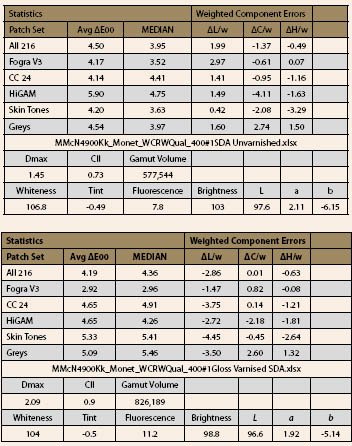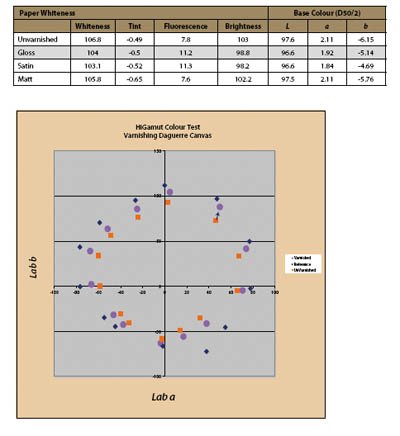articles/Photofinishing/hahnemuhlevarnishes-page2
Paper Chase - Hahnemuhle Varnishes - part 2 of 1 2
by Mike McNamee Published 01/06/2012

Auditing the Colour
The unvarnished prints were measured to provide baseline data and then the process repeated after coating. In order to get a gamut volume measurement the profile-building patches were used to make profiles from the varnished and then the unvarnished target. In a perfect world an audit print should be made using an icc profile made from a varnished target to get the best from the combination, but we declined this option.
The gamut volume was extended by some 43% with the application of the varnish and the prints were enlivened by the increased saturation. The depth was also much greater raising the Dmax from1.45 to 2.09 for the gloss. In general the effect of varnish was greatest for gloss followed by satin and then matt. The matt varnish actually depressed the Dmax. In summary, the effect of the varnish was to darken the print, reduce the saturation error-component and to have very little effect on the hue - these are essentially neutral-coloured varnishes. The effect on the whiteness parameters was measured separately.

Whiteness Measurement Varnishes have the greatest influence on the whiteness parameters of a surface. In this case the three products had a minimal effect on the base properties. They caused an overall loss of Lab Lightness of around 1%, but had no effect on either the colour or the fluorescence. These varnishes are quite different to both DCP Giclee Varnish and Premier Clearshield, both of which suppress OBA activity by screening out the incoming UV component of the light. This means that the brightness of print is fully maintained and provides a useful alternative to the competitors' offerings. We have always felt that there is little point using a brightened paper for its additional 'pop' and then screening the UV out so that it is lost - you might as well start with an OBA-free coating
Summary
These three varnishes are a good addition to the market, providing a tough coating for a canvas without influencing the brightness but significantly increasing the colour saturation and gamut. They proved to be easy to use with no apparent vices. They are water soluble and relatively odourfree making them easy to live with, not an insignificant point if you operate in a mixed domestic/business environment.
The easy-to-open jars are a bonus!
Please Note:
There is more than one page for this Article.
You are currently on page 2 Contact Mike McNamee
1st Published 01/06/2012
last update 09/12/2022 14:54:52
More Photofinishing Articles
There are 0 days to get ready for The Society of Photographers Convention and Trade Show at The Novotel London West, Hammersmith ...
which starts on Wednesday 15th January 2025





